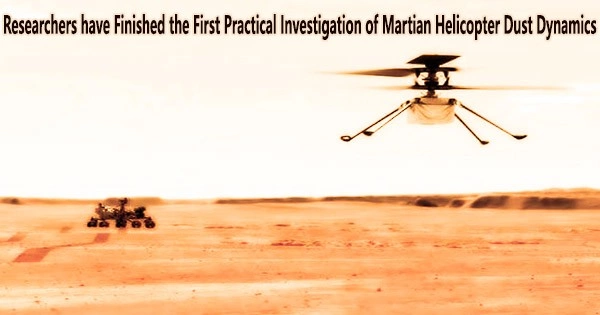Mars is a dusty planet. For scientific missions, dust poses a persistent problem, from microscopic dust devils to enormous storms that cover the entire planet. This was particularly true for Ingenuity, the rotorcraft that has been exploring Mars with the Perseverance rover since February 2021.
Future extraterrestrial rotorcraft missions can now move forward thanks to the work of scientists at Stevens Institute of Technology, the Space Science Institute, and the Jet Propulsion Laboratory who have finished the first real-world study of Martian dust dynamics based on Ingenuity’s historic first flights on the Red Planet.
The work, reported in the December 2022 issue of Journal of Geophysical Research: Planets, could support NASA’s Mars Sample Return Program, which will retrieve samples collected by Perseverance or the Dragonfly mission that will set course for Titan, Saturn’s largest moon, in 2027.
“There’s a reason that helicopter pilots on Earth prefer to land on helipads,” said Jason Rabinovitch, a co-author and assistant professor at Stevens. “When a helicopter lands in the desert, its downdraft can stir up enough dust to cause a zero-visibility ‘brownout’ and Mars is effectively one big desert.”
Rabinovitch has been working on the Ingenuity program since 2014, joining the Jet Propulsion Laboratory soon after the concept was first pitched to NASA and creating the first theoretical models of helicopter dust lifting in dusty Martian environments.
When you think about dust on Mars, you have to consider not just the lower gravity, but also the effects of air pressure, temperature, air density there’s a lot we don’t yet fully understand.
Jason Rabinovitch
At Stevens, Rabinovitch continues to work with JPL and investigates plume-surface interactions during the powered descent of a spacecraft. He also models supersonic parachute inflation and geophysical phenomena, such as plumes on Enceladus.
Studying dust dynamics on another planet isn’t easy, explained Rabinovitch. “Space is a data-poor environment. It’s hard to send videos and images back to Earth, so we have to work with what we can get.”
To address that difficulty, Rabinovitch and associates at JPL used cutting-edge image-processing methods to retrieve data from six helicopter trips, all of which were recorded in low-resolution films by Perseverance.
The researchers were able to determine the amount and overall quantity of dust clouds produced while Ingenuity lifted off, hovered, navigated, and landed by recognizing minute differences between video frames and the light intensity of individual pixels.
Given the scant information that was provided to the team back in 2014, when Rabinovitch and his colleagues were generating back-of-the-envelope calculations designed to support the first design of Ingenuity, the results were within striking distance of Rabinovitch’s engineering models.
According to the research, dust is a major factor for extraterrestrial rotorcraft, and Ingenuity is estimated to have generated four pounds of dust per flight, or nearly a thousandth of its own mass. That’s many times more dust than would be generated by an equivalent helicopter on Earth, though Rabinovitch cautions that it’s tricky to draw direct comparisons.
“It was exciting to see the Mastcam-Z video from Perseverance, which was taken for engineering reasons, ended up showing Ingenuity lifting so much dust from the surface that it opened a new line of research,” said Mark Lemmon, a senior research scientist at the Space Science Institute Mars Science Laboratory and first author of the study.
“When you think about dust on Mars, you have to consider not just the lower gravity, but also the effects of air pressure, temperature, air density there’s a lot we don’t yet fully understand,” Rabinovich said. Still, he added, that’s what makes studying Ingenuity’s dust clouds so exciting.
By extending the life of solar panels on upcoming robotic missions and making it simpler to deploy delicate equipment safely on the dusty Martian surface, a greater knowledge of brownouts could aid NASA in extending the duration of these missions.
Additionally, it might provide fresh perspectives on how wind and dust carried by the wind affect weather patterns and erosion both on Earth and in harsh locations throughout the Solar System.





